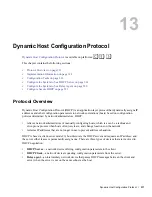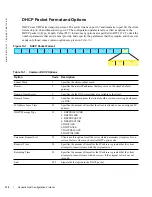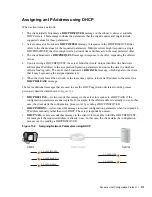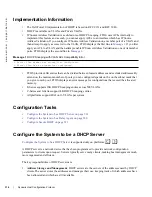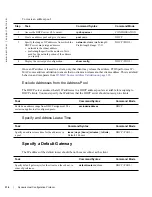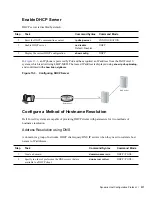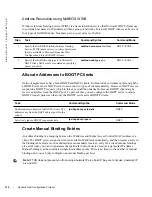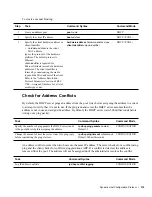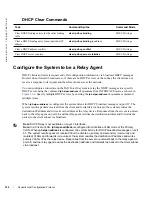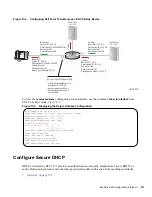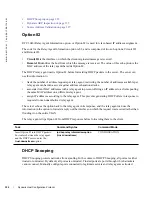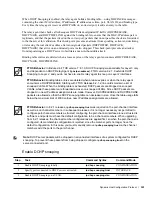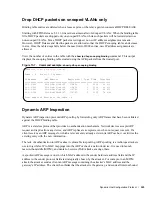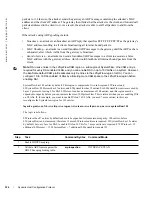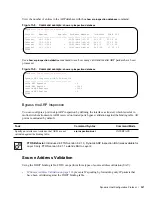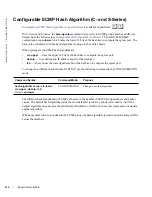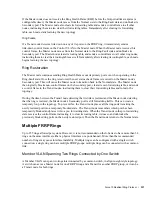
Dynamic Host Configuration Protocol |
323
When DHCP Snooping is enabled, the relay agent builds a binding table—using DHCPACK messages—
containing the client MAC address, IP addresses, IP address lease time, port, VLAN ID, and binding type.
Every time the relay agent receives a DHCPACK on an trusted port, it adds an entry to the table.
The relay agent then checks all subsequent DHCP client-originated IP traffic (DHCPRELEASE,
DHCPNACK, and DHCPDECLINE) against the binding table to ensure that the MAC-IP address pair is
legitimate, and that the packet arrived on the correct port; packets that do not pass this check are forwarded
to the the server for validation. This check-point prevents an attacker from spoofing a client and declining
or releasing the real client’s address. Server-originated packets (DHCPOFFER, DHCPACK,
DHCPNACK) that arrive on an untrusted port are also dropped. This check-point prevents an attacker
from impostering as a DHCP server to facilitate a man-in-the-middle attack.
Binding table entries are deleted when a lease expires, or the relay agent encounters a DHCPRELEASE,
DHCPNACK, DHCPDECLINE.
Enable DCHP snooping
FTOS Behavior:
Introduced in FTOS version 7.8.1.0, DHCP Snooping was available for Layer 3 only
and dependent on DHCP Relay Agent (
ip helper-address
). FTOS version 8.2.1.0 extends DHCP
Snooping to Layer 2, and you do not have to enable relay agent to snoop on Layer 2 interfaces.
FTOS Behavior:
Binding table entries are deleted when a lease expires or when the relay agent
encounters a DHCPRELEASE. Starting with FTOS Release 8.2.1.2, line cards maintain a list of
snooped VLANs. When the binding table is exhausted, DHCP packets are dropped on snooped
VLANs, while these packets are forwarded across non-snooped VLANs. Since DHCP packets are
dropped, no new IP address assignments are made. However, DHCPRELEASE and DHCPDECLINE
packets are allowed so that the DHCP snooping table can decrease in size. Once the table usage falls
below the maximum limit of 4000 entries, new IP address assignments are allowed.
q
FTOS Behavior:
In 8.2.1 releases,
ip dhcp snooping trust
was required on the port-channel interface
as well as on channel members. In subsequent releases, it is no longer necessary nor permitted to
configure port-channel members as trusted; configuring the port-channel interface alone as trusted is
sufficient, and ports must have the default configuration to be a channel members. When upgrading
from 8.2.1 releases, the channel-member configurations are applied first, so when the port-channel is
configured, its membership configuration is rejected, since the member ports no longer have the
default configuration. In this case, you must manually remove
ip dhcp snooping trust
on the channel
members add the ports to the port-channel.
Note:
DHCP server packets will be dropped on all untrusted interfaces of a system configured for DHCP
snooping. To prevent these packets from being dropped, configure
ip dhcp snooping trust
on the
server-connected port.
Step
Task
Command Syntax
Command Mode
1
Enable DHCP Snooping globally.
ip dhcp snooping
CONFIGURATION
2
Specify ports connected to DHCP servers as trusted.
ip dhcp snooping trust
INTERFACE
3
Enable DHCP Snooping on a VLAN.
ip dhcp snooping vlan
CONFIGURATION
Summary of Contents for Force10 E300
Page 1: ...FTOS Configuration Guide FTOS 8 4 2 7 E Series TeraScale C Series S Series S50 S25 ...
Page 32: ...32 w w w d e l l c o m s u p p o r t d e l l c o m ...
Page 132: ...132 802 1X w w w d e l l c o m s u p p o r t d e l l c o m ...
Page 310: ...310 Configuration Replace and Rollback w w w d e l l c o m s u p p o r t d e l l c o m ...
Page 330: ...330 Dynamic Host Configuration Protocol w w w d e l l c o m s u p p o r t d e l l c o m ...
Page 402: ...402 High Availability w w w d e l l c o m s u p p o r t d e l l c o m ...
Page 462: ...462 Interfaces w w w d e l l c o m s u p p o r t d e l l c o m ...
Page 482: ...482 IPv4 Addressing w w w d e l l c o m s u p p o r t d e l l c o m ...
Page 506: ...506 IPv6 Addressing w w w d e l l c o m s u p p o r t d e l l c o m ...
Page 582: ...582 Layer 2 w w w d e l l c o m s u p p o r t d e l l c o m ...
Page 642: ...642 Multicast Source Discovery Protocol w w w d e l l c o m s u p p o r t d e l l c o m ...
Page 662: ...662 Multiple Spanning Tree Protocol w w w d e l l c o m s u p p o r t d e l l c o m ...
Page 690: ...690 Object Tracking w w w d e l l c o m s u p p o r t d e l l c o m ...
Page 754: ...754 PIM Dense Mode w w w d e l l c o m s u p p o r t d e l l c o m ...
Page 784: ...784 PIM Source Specific Mode w w w d e l l c o m s u p p o r t d e l l c o m ...
Page 800: ...800 Power over Ethernet w w w d e l l c o m s u p p o r t d e l l c o m ...
Page 876: ...876 Quality of Service w w w d e l l c o m s u p p o r t d e l l c o m ...
Page 892: ...892 Routing Information Protocol w w w d e l l c o m s u p p o r t d e l l c o m ...
Page 1006: ...1006 Simple Network Management Protocol w w w d e l l c o m s u p p o r t d e l l c o m ...
Page 1018: ...1018 SONET SDH w w w d e l l c o m s u p p o r t d e l l c o m ...
Page 1048: ...1048 Broadcast Storm Control w w w d e l l c o m s u p p o r t d e l l c o m ...
Page 1096: ...1096 Uplink Failure Detection UFD w w w d e l l c o m s u p p o r t d e l l c o m ...
Page 1098: ...1098 Upgrade Procedures w w w d e l l c o m s u p p o r t d e l l c o m ...
Page 1196: ...1196 C Series Debugging and Diagnostics w w w d e l l c o m s u p p o r t d e l l c o m ...
Page 1252: ...1252 Standards Compliance w w w d e l l c o m s u p p o r t d e l l c o m ...
Page 1262: ...1262 Index w w w d e l l c o m s u p p o r t d e l l c o m ...



